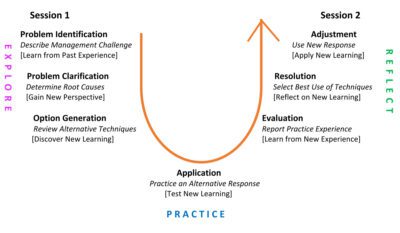“Collaboration allows us to know more than we are capable of knowing by ourselves.” Paul Solarz
Last week, I introduced The Peer Learning Group. This week, I’d like to provide more specific information about The Peer Learning Group Model, which is a collaborative peer-based learning approach.
The Peer Learning Group Model is based on U-theory, so it looks like this:

The peer learning groups form (engage) to discuss a specific management challenge, using module materials that we provide.
Every module involves two 90-minute sessions, a practice session in the intervening time, and a post-session. In Session 1, the managers share their knowledge and experience and learn new techniques. More specifically, group members: identify their problems and clarify the root causes as they share their stories about the management issue and discuss their experiences. They collaborate to build their knowledge and skills (with written reference materials, exercises, job aids and/or videos we provide) to generate options for handling their particular challenges; and plan to apply their new learning.
Between Sessions 1 and 2, the managers practice using techniques they learned or applying new knowledge that they jointly created during Session 1. Each group member practices a newly learned strategy and completes a practice report worksheet to share during Session 2. This gives them time, usually a month, to use the new strategies to see how well they work and what, if anything, needs to be done to tweak the strategies to make them as effective as possible in their worksite. During the practice session, the managers are expected to analyze what happened, why they think it happened, what they can learn from it. and how they could use and/or improve the strategy.
In Session 2, when the managers return for the second session, they report back and learn from each other’s experiences. The group is able to make decisions about what strategy works best. This builds their competence and ensures that there is both quality and consistency in the actions that the managers take to handle similar situations in the future.
After the module, the managers’ supervisors are expected to monitor and support the managers’ new more effective behaviors.
So, that’s the plan. Please let me know what you think about The Peer Learning Group Model. Thank you!
If this sounds interesting, I encourage you to check out our website: http://www.peerlearninggroup.com
May your learning be sweet.
Deborah





